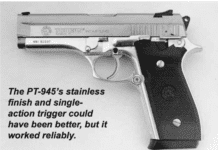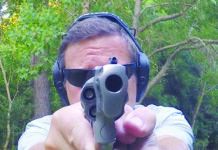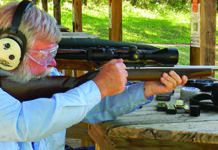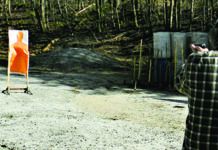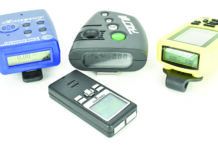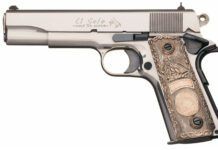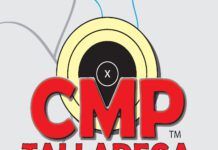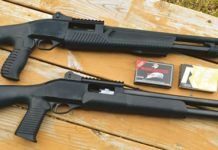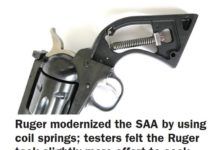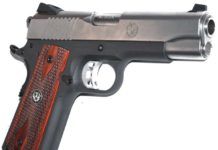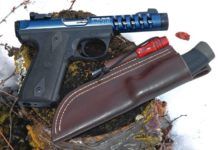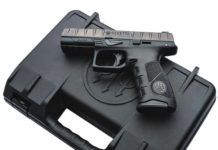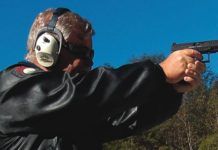Magnum Research Desert Eagle Animal Prints
Magnum Research Introduces New Animal Prints on Desert Eagles
Following the success of its Cheetah print for the Desert Eagle, Magnum Research has introduced two new prints — the Kryptek Highlander and the Snakeskin, available in either .50 AE or .44 Mag.
Tactical Pump Shotguns: CZ-USA HC Versus Weatherby
Specific-use firearms such as tactical shotguns that are designed for self-defense situations are held to a higher standard than other shooting tools. If a self-defense shotgun fails to function or inadequately performs at the wrong time, there is no such thing as a do-over. Admittedly, most of these shotguns will never be fired in a life-or-death situation and generally don't see a lot of time on the shooting range. That does not mean the tactical shotgun owner does not demand the shooting tool, when it is necessary, handle its duties in an efficient and effective manner.
This is the first of two tactical pump-action shotgun evaluations. The next head-to-head match will feature a Tristar TEC-12 Pump/Auto 12 gauge listing for $689 against a Mossberg Model 590 Magpul Pump 12 gauge listing for $773. In that review, we will also name Our Pick of the four shotguns put through exactly the same test drills.
For this test, we selected a couple moderately priced pumps to see how they fared on the shooting range and whether they met the high standards of a firearm that might mean the difference between life and death. The two 12-gauge pump-action shotguns, both available for less than $500, that we put through their paces are the Weatherby PA-459 TR with a manufacturer's suggested retail price of $499 and the CZ-USA Model 612 HC-P 12 gauge (last reviewed in October 2013) listing for $366.
When a shooter absolutely, positively, without-a-doubt has to stop a threat, he or she can't have doubts about whether a firearm will function in a proper and effective manner. Not only does the self-defense firearm have to perform well, a shooter must have confidence the pattern will be placed on target in an effective manner. Also, a key element in any self-defense training is that the shooter is responsible for any lead that comes down the barrel in a shooting situation. Wounding or killing an innocent bystander with an errant pellet or slug is simply unacceptable on both moral and legal levels.
Spending time on the range to know how well a shotgun performs is a necessary factor with self-defense shotguns. Understanding that a typical tactical firearm packs quite a punch on both ends, we endured quite a bit of shoulder shock in conducting evaluations on these firearms. We encourage individuals who purchase these firearms do the same so they will become familiar with their specific self-defense tool.
Our ammunition for putting the two close-quarter shotguns into play included Rio Royal Buck 2.75-inch loads moving nine pellets of No. 00 buckshot at an average muzzle velocity of 1,345 fps; and Winchester Reduced Recoil Winlite 2.75-inch loads pushing 0.9-ounce 400-grain Sabot Slugs with an average muzzle velocity of 1,450 fps. In addition, our repeated function-fire and cycling rounds as part of the testing sequence were Remington ShurShot Heavy Dove 2.75-inch loads with 11⁄8 ounces of No. 6 shot moving at an average of 1,255 fps.
Rather than the standard patterning board used for our other shotgun testing, we utilized Birchwood Casey Eze-Scorer 23-inch by 35-inch Bad Guy and the same size Targets Online paper images of potential threats for our shots in home-defense simulations; and Champion VisiColor Zombies 12-inch by 18-inch Slasher Tusks targets for slug shots at 25 yards. On the zombies, only head shots were counted as acceptable results with the slug ammo. Here are our findings:
Convertible Flattops: Lipseys Blackhawk and New Frontier
Colt started to put adjustable sights on its single-action revolvers around 1890 to fill a need for target shooters. Most single actions of the day, and, in fact, to the present, feature simple fixed sights; a blade front and rear consisting of a groove milled along the top strap. These sights suffice for most shooters, though some Kentucky windage and elevation are required with some models that did not shoot to point of aim. Adjustable sights take out the guesswork since they can be adjusted to any load being fired. Colt named the single action with adjustable sights the Flattop Target Model, and these First Generation revolvers were shipped from 1888 to 1896 with fewer than 1,000 made. Obviously, they are quite rare. Bisley models were also offered as Flattop Target Models, and even fewer of these models were produced. What these first Flattop revolvers featured was a replaceable front-sight blade to adjust elevation and a rear sight that was drift-adjustable for windage. Since the rear sight groove was not needed, the top strap of the frame was machined, flat hence the name "Flattop."
The two flattops we tested recently were a used Third Generation Colt New Frontier and a new Lipsey's exclusive Ruger New Model Blackhawk. Both wore aftermarket grips, and from outward appearances, looked nearly identical. What piqued our interest in these two revolvers was they were also convertibles with an extra cylinder. One cylinder was chambered in 45 Colt (sometimes called Long Colt to ensure it doesn't get confused with a shortened pronunciation of Automatic Colt Pistol) and the other was chambered in 45 ACP. Both cartridges are very popular, and 45 ACP made these six-shooters compatible with ammo normally used in a semi-automatic pistol.
The operating systems of each revolver are what distinguish them. The New Frontier is an old-school single action with no built-in safety, so it must be carried with the hammer resting on an empty chamber to guard against discharges if dropped. The Ruger New Model Blackhawk incorporates a transfer-bar safety mechanism that allows the revolver to be carried with all chambers loaded. The Colt uses a flat mainspring and flat springs throughout, and the Ruger uses a coiled mainspring as well as coiled springs throughout.
We used a revolver range rod and rod head combo from Brownells in 45 Auto/45 Colt (080-617-045WB, $42) to check each chamber for alignment with the bore. We found no issues. Next we looked at headspace—the space between the recoil shield of the frame and the rear of the cylinder—and assumed all would be fine since the Ruger was new the Colt looked unused. Again, our assumption was confirmed with Clymer No-Go gauges from Brownells in 45 Auto (184-000-041WB, $60) and 45 Long Colt (184-100-511WB, $30). Both cylinders for both revolvers have non-rebated cylinders. The headspace check process was a bit different for each revolver. For the Colt, we put the hammer on half-cock and opened the loading gate; for the Ruger, we just had to open the loading gate and drop the No-Go gauge into a chamber. If correct, the gauge stops the cylinder's rotation. This was repeated with all 24 chambers;12 for both 45 Colt cylinders and 12 for the two 45 ACP cylinders. With the Colt, the No-Go gauge is removed only after removing the cylinder. The process is tedious, but it's warranted to ensure the safety of a used revolver. The Ruger has a reversing pawl, like Ruger's Vaquero models, so the process is quicker. So is unloading the Ruger, but we'll get to that. Finally, we checked the cylinder-to-barrel space, aka cylinder gap, using a Brownells feeler gauger (606-950-252WB, $28). The space should spec out between 0.004 to 0.006 inch. We found the dimension on the Colt was 0.007 inch for each cylinder. On the Ruger, the 45 Colt cylinder gap measured 0.005 inch and the 45 ACP cylinder was 0.006 inch.
With the pistols all checked out, we were then able to get to the fun part and begin shooting them. Here's how that went:
Leupold’s New Delta Point Sight
Watch as Tom Moyle, product line manager for Leupold and Stevens demonstrates some of the great features and benefits to their Delta Point Sight. The Delta Point has a light weight magnesium housing, a 3mm aspheric glass lens which allows for clear objective sighting and much more. Click below for Tom's full product demonstration in this exclusive Gun Tests product demonstration:
Insight’s Combined Laser and LED Sights
Laser sights are fine, but sometimes you need to illuminate the target--or find it--before firing. Insight's combined laser sights and lights do exactly that. At SHOT 2010, they're introducing a new line that includes bright but power-saving LEDs.
Tactical 1911 Pistol Shoot Out: SIG Sauer Vs. Smith & Wesson
The 1911 handgun has survived for more than one hundred years based on excellent ergonomics, great reliability, and its ability to chamber a fight-stopping cartridge. Modern 1911 handguns are much evolved from the Colt 1911 first issued to Army troops in 1911. However, a doughboy going to Europe in 1917 would be able to instantly load, make safe, fire and use a modern 1911 handgun. The ability of the platform to accept a weapon-mounted light was an inevitable part of the 1911's evolution, because a gun-mounted combat light is a good tactical addition. They allow for the identification of a threat, illumination of an area, and make fail-safe identification possible.
Two so-equipped full-size 1911s are the SIG TACOPS and the Smith & Wesson 1911TA E Class. The SIG Sauer 1911 TACOPS 1911R-45TACOPS, $1213 list, is a no-nonsense black tactical pistol. We found it at DefenderOutdoors.com for $1,080, at BudsGunShop.com for a cash discount price of $1,062, and for $910 at GrabAGun.com. Our test gun is part of the larger SIG 1911 family, which at our last count, had 31 members. Generally speaking, SIG 1911s have done very well in our evaluations. In the October 2014 issue, we graded a 1911 Carry Scorpion 1911CAR-45-SCPN as a B+. In the November 2013 issue, a 1911 Carry Stainless 1911CA-45-SSS earned an A- grade and a "Best Buy" nod. In the February 2009 issue, a 1911 C3 No. 19GS0031 earned an A grade. In the May 2006 issue, a Sigarms 1911 GSR No. 19GS0001 earned a Conditional Buy, mainly because of its price, not its functionality. We'd translate that to a B+ today.
S&W's SW1911 "E" Series pistols are supposed to be "enhanced, with tight tolerances, precision-fit trigger, chamfered and recessed muzzle, "fish-scale" scalloped slide serrations and other premium features commonly found on custom-made firearms. The standard E-series 1911s come in blued or stainless steel, and the model number with "SC" appended have scandium-alloy frames. The blued version we tested is #108409, while the stainless model is #108411. List for our test gun is $1399, and we saw it for sale at DefenderOutdoors.com for $1140, TombstoneTactical.com for $1099, and at BudsGunShop.com for $1065.
Smith 1911s have not matched SIG's level of performance in our tests. In the April 2010 issue, the S&W Model SW1911 No. 178017 in 9mm got a B+. A 45 ACP Smith & Wesson MSW1911 No. 108284 earned a B+ in the February 2010 issue. In March 2006, a 1911SC No. 108289 got a "Don't Buy" rating, as did a 1911PD No. 108296 tested in the November 2005. Way back in April 2003, we tested the first-year version of the company's 1911 and said "Buy It" to a Smith & Wesson 1911 45 ACP.
But history isn't necessarily destiny at Gun Tests. Out of the box, the Smith & Wesson had more bling and eye appeal, no denying that. And at the heart of each pistol was a tight barrel-to-slide fit, which provided X-ring accuracy without sacrificing reliability. Just like you, we prefer to shoot good guns, and what we found here were two pretty good ones, though our team had its preference at the end.
Rugers Lightweight Commander
Colt still makes the Lightweight Commander (O4860XSE, $1104), but no longer makes one of our favorite carry guns, the CCO, or Colt Concealed Officer's model. We thought this Ruger looked enough like the Colt CCO that a comparison was in order. In this first-look report, we take a good look at the new Ruger and briefly see how it stacks up to a custom CCO on hand.
We shot the Ruger with 230-grain FMJ "hardball" by Black Hills and Winchester, Winchester's 200-grain BEB, and with Federal 185-grain JHP Hi-Shok. We tried a few rounds of Cor-Bon 185-grain JHP, but found the recoil to be much too fierce. Here's what we found from our first look at the new Ruger.
Three Trail Companions We Like
The avid woodsman or outdoorsman, be he/she hunter, hiker, camper, or what have you, has certain necessary items that must always be packed along on the trail. Whether going into the Eastern woods for a few days or into the Western mountains, those companion items will always go along with us: water, fire makings, rope, shelter, and the like. Many of us also want a pistol and knife. In this report we take a close first look at Ruger's new 22/45 Lite in 22 LR and the Mora HD knife and an accompanying Scow Sheath as trail companions.
We must comment that lately we now consider taking quite a few more items for our forays into the bush, thanks to a fellow who is one of the more serious outdoorsmen we've encountered. This is one David Pearson, who has posted nearly 100 rather lengthy, intelligent, thoughtful, educational, and highly entertaining videos on YouTube under the moniker reallybigmonkey1. With his heavy and pleasant Appalachian accent, Mr. Pearson shows in great detail how he deals with the varied aspects of serious camping in his neighborhood of northwest Georgia. This includes making off-the-ground beds, low-cost heated shelters of a great variety, dealing with fires and cooking, the use of rather large knives, and making much of his own equipment, all dealt up with a great deal of self-effacing humor — and absolutely no swearing. Mr. Pearson calls his educational videos "Fun in the Woods."
Though some of us are essentially outdoorsmen, we have learned quite a bit from Mr. Pearson. More to the point, one of Pearson's videos gave us a heads-up about Duane Scow, whose custom sheath for the Mora knife was shown in one of Pearson's videos. But for now, we'll look at the packable pistol from Ruger, then address the qualities of the knife and sheath.
The Pig Box and TSA
I admit I was miffed when the Transportation Security Administration (TSA) opened a computer case I checked as baggage to Las Vegas for the SHOT Show back in January. The case and contents were a load — a 38-pound Pelican 1730 transport case with a 27-inch iMac in it. I prefer to use a desktop machine to update the Gun Tests Facebook page, YouTube page, website, and new-product files when I'm at SHOT for a week. I've done the jobs with a laptop before, and I admit, it's much easier to carry-on a smaller machine. But once it's set up, the full-size iMac is heaven while we're processing words, photos, and movies for our various media in a hurry. In previous years, I had shipped my back-up iMac 27 in its original box a few days prior, so I hadn't had to wrestle what I lovingly refer to as the Pig Box through airport check in. I call it that because the Pelican is big enough (37.5 x 27.1 x 14.4 inches) to hold a whole pig. Oh yes, extra weight and size charges apply.
Beretta Unveils APX Striker Gun
Beretta's APX, a new striker-fired full-size pistol in 9x19mm, 9x21mm IMI and 40 Smith & Wesson cartridges, debuted at the 2015 International Defence Exhibition & Conference IDEX expo in Abu Dhabi Feb. 22.
"IDEX is one of the first venues where defense contractors present their wares to worldwide military customers and Beretta felt this was the ideal environment to present the international offering of its APX pistol," said Carlo Ferlito, general manager of Beretta and Beretta Defense Technologies (BDT) vice president.
Beretta intends to market a variant for the commercial market later this year. The new Beretta APX has an ergonomically-molded reinforced polymer frame fitted with a built-in MIL-STD-1913 Picatinny rail, interchangable backstraps and grip panels, and a modified Browning locking system. The APX is 7.56 inches long with a 4.25-inch barrel.
The trigger can be considered a light double action, with a 6-pound break, 0.2 inch of travel, and a 0.12-inch reset. The rear portion of the striker slightly protrudes from a round slot on the back of the slide as a loaded-chamber indicator.
The slide is machined from stainless steel and has a nitride coating that reduces glare, scratches, and corrosion. Other features include wide front and rear slide serrations, three-dot sights dovetailed into the slide, and no manual safety save for a Glock-style trigger safety.
Ferlito said, "Beretta waited to enter the striker-fired market until we had a pistol we knew would meet the needs of the operator. The APX has been more than three years in development. We tested it extensively with professional end users and incorporated that feedback at every opportunity. The result is a pistol platform that delivers superior performance in durability, reliability, accuracy and ergonomics."
A slot on the frame allows the use of a tool to decock it before it can be field-stripped by operating a lever found on the left side of the frame.
An optional manual safety system will be available upon request, consisting of a frame-mounted two-position switch. A reversible magazine-release catch and a factory ambidextrous slide stop/hold open release lever help make the pistol suitable for left- or right-handed shooters.
Supplied black double-stack metal magazines have polymer bottom pads and offer 17-round capacities in 9x19mm NATO and 15-round capacities in 9x21mm IMI (9 Italian) and 40 Smith & Wesson.
JOX Loader Pouch Test
Many Americans choose a revolver as their concealed-carry handguns. Most carry a snubnose revolver; a few carry a 4-inch barrel 357 Magnum like those tested elsewhere in this issue. Their faith in the revolver is understandable. Our raters observe that criminals often run in packs. The natural polarity between good guys and bad guys may erupt into a gun battle. While high-round counts are not the norm, the possibilities are endless. At any rate, after you win the fight, you will wish to reload the handgun, which means carrying spare gun loads - a somewhat more difficult task than with magazines for a self loader. We believe the reason the revolver reload isnt carried as often is because of the bulk of speedloaders, and carrying loose ammunition in the pocket is a bad choice. Revolver speed strips help, but are far from ideal. In our view, a revolver speedloader is best, but they are about as wide as the revolver cylinder, which makes for a bump on the belt with conventional old-style speedloader pouches.
Polymer-Frame 9mm Shoot Out: P320 Versus PPQ M2 Vs. VP9
During the past few months, SIG Sauer, Walther, and Heckler & Koch have introduced pistols that feature striker-fired actions. These handguns are designed to compete for the hearts and minds of institutional buyers and concealed-carry-permit holsters as well. The improvement in rapid-fire combat shooting is provable, and absolute accuracy is improved over the original SIG P250, Walther P99 and HK P30. The question is, which handgun is the most improved and the best buy for the money — that is, the most reliable and accurate?
In this test of three 9mm striker-fired models, we were firing handguns intended for personal defense in the home, concealed carry, and practical competition. We are certain each maker is hoping to compete with Glock for institutional sales as well. At first glance, the handguns appeared similar. Each featured a polymer frame, a light rail, and similar sights. Each was relatively simple to operate. None had a manual safety as part of the design. Some features, such as the sights and the magazines, were similar. A casual shooter might sign off on all three handguns, but that isn't what we do.
Our shooters noticed the trigger actions were markedly different, and grip texturing and handling were considerably different. As the firing sessions progressed and the brass stacked up, the shoot out turned into a strong challenge between the Walther and the HK pistol. These worthy competitors traded places several times in the firing evaluations. The SIG P320 brought up the rear, in our estimation. Here's why:




